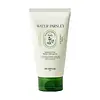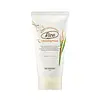What's inside
What's inside
 Key Ingredients
Key Ingredients

 Benefits
Benefits

 Concerns
Concerns

 Ingredients Side-by-side
Ingredients Side-by-side

Oenanthe Javanica Extract 15%
AntimicrobialWater
Skin ConditioningGlycerin
HumectantMethylpropanediol
SolventPalmitic Acid
EmollientStearic Acid
CleansingMyristic Acid
CleansingPotassium Hydroxide
BufferingLauric Acid
CleansingPotassium Cocoyl Glycinate
Salicylic Acid
MaskingCoco-Glucoside
CleansingGlyceryl Stearates
EmollientCentella Asiatica Extract
CleansingFicus Carica Fruit Extract
HumectantCarthamus Tinctorius Flower Extract
Skin ConditioningGardenia Florida Fruit Extract
Skin ConditioningHamamelis Virginiana Bark/Leaf/Twig Extract
Skin ConditioningSalix Alba Bark Extract
AstringentPogostemon Cablin Leaf Oil
MaskingJuniperus Virginiana Oil
MaskingArtemisia Vulgaris Oil
PerfumingMentha Arvensis Leaf Oil
MaskingHydrogenated Lecithin
EmulsifyingBetaine
HumectantSorbitan Olivate
EmulsifyingPolyquaternium-22
Beta-Glucan
Skin ConditioningAllantoin
Skin ConditioningGluconolactone
Skin ConditioningSodium Phytate
Capryloyl Salicylic Acid
ExfoliatingPanthenol
Skin ConditioningCeramide NP
Skin ConditioningNiacinamide
SmoothingLinolenic Acid
CleansingBiotin
AntiseborrhoeicCyanocobalamin
Skin ConditioningAscorbic Acid
AntioxidantTocopheryl Acetate
AntioxidantPantothenic Acid
Skin Conditioning1,2-Hexanediol
Skin ConditioningOenanthe Javanica Extract 15%, Water, Glycerin, Methylpropanediol, Palmitic Acid, Stearic Acid, Myristic Acid, Potassium Hydroxide, Lauric Acid, Potassium Cocoyl Glycinate, Salicylic Acid, Coco-Glucoside, Glyceryl Stearates, Centella Asiatica Extract, Ficus Carica Fruit Extract, Carthamus Tinctorius Flower Extract, Gardenia Florida Fruit Extract, Hamamelis Virginiana Bark/Leaf/Twig Extract, Salix Alba Bark Extract, Pogostemon Cablin Leaf Oil, Juniperus Virginiana Oil, Artemisia Vulgaris Oil, Mentha Arvensis Leaf Oil, Hydrogenated Lecithin, Betaine, Sorbitan Olivate, Polyquaternium-22, Beta-Glucan, Allantoin, Gluconolactone, Sodium Phytate, Capryloyl Salicylic Acid, Panthenol, Ceramide NP, Niacinamide, Linolenic Acid, Biotin, Cyanocobalamin, Ascorbic Acid, Tocopheryl Acetate, Pantothenic Acid, 1,2-Hexanediol
Water
Skin ConditioningMyristic Acid
CleansingGlycerin
HumectantStearic Acid
CleansingPotassium Hydroxide
BufferingOryza Sativa Bran Water
MaskingLauric Acid
CleansingLauryl Betaine
CleansingGlyceryl Stearate Se
EmulsifyingSodium Cocoyl Apple Amino Acids
Skin ConditioningPolyquaternium-7
Sodium Chloride
MaskingCetearyl Olivate
Panthenol
Skin ConditioningSorbitan Olivate
EmulsifyingHexylene Glycol
EmulsifyingAllantoin
Skin ConditioningSodium Benzoate
MaskingDisodium EDTA
Oryza Sativa Extract
AbsorbentSodium Hyaluronate
HumectantCitric Acid
BufferingButylene Glycol
HumectantAspergillus Ferment
Skin ConditioningCeramide AP
Skin Conditioning1,2-Hexanediol
Skin ConditioningParfum
MaskingWater, Myristic Acid, Glycerin, Stearic Acid, Potassium Hydroxide, Oryza Sativa Bran Water, Lauric Acid, Lauryl Betaine, Glyceryl Stearate Se, Sodium Cocoyl Apple Amino Acids, Polyquaternium-7, Sodium Chloride, Cetearyl Olivate, Panthenol, Sorbitan Olivate, Hexylene Glycol, Allantoin, Sodium Benzoate, Disodium EDTA, Oryza Sativa Extract, Sodium Hyaluronate, Citric Acid, Butylene Glycol, Aspergillus Ferment, Ceramide AP, 1,2-Hexanediol, Parfum
Ingredients Explained
These ingredients are found in both products.
Ingredients higher up in an ingredient list are typically present in a larger amount.
1,2-Hexanediol is a synthetic liquid and another multi-functional powerhouse.
It is a:
- Humectant, drawing moisture into the skin
- Emollient, helping to soften skin
- Solvent, dispersing and stabilizing formulas
- Preservative booster, enhancing the antimicrobial activity of other preservatives
Allantoin is a soothing ingredient known for its protective and moisturizingg properties. Because of this, it is often added to products with strong active ingredients.
Studies show higher concentrations of this ingredient can promote wound healing.
Though it can be derived from the comfrey plant, allantoin is produced synthetically for cosmetic products to ensure purity.
Learn more about AllantoinGlycerin is already naturally found in your skin. It helps moisturize and protect your skin.
A study from 2016 found glycerin to be more effective as a humectant than AHAs and hyaluronic acid.
As a humectant, it helps the skin stay hydrated by pulling moisture to your skin. The low molecular weight of glycerin allows it to pull moisture into the deeper layers of your skin.
Hydrated skin improves your skin barrier; Your skin barrier helps protect against irritants and bacteria.
Glycerin has also been found to have antimicrobial and antiviral properties. Due to these properties, glycerin is often used in wound and burn treatments.
In cosmetics, glycerin is usually derived from plants such as soybean or palm. However, it can also be sourced from animals, such as tallow or animal fat.
This ingredient is organic, colorless, odorless, and non-toxic.
Glycerin is the name for this ingredient in American English. British English uses Glycerol/Glycerine.
Learn more about GlycerinLauric Acid is a fatty acid or lipid. About half of fatty acids in coconut oil is lauric acid.
This ingredient helps hydrate and sooth skin. As a humectant, it helps trap moisture. It also aids in cleaning and enhancing the texture of products.
Lauric acid may not be Malassezia folliculitis, or fungal acne, safe.
Learn more about Lauric AcidMyristic Acid is a saturated fatty acid. It is naturally found in milk fat. Other sources include palm oil, coconut oil, and butter fat.
Myristic Acid is an emulsifer and cleanser. As an emulsifer, it stabilizes a product by preventing ingredients from separating. Myristic Acid helps clean your skin by acting as a surfactant. It tends to gather oil and dirt on your skin to be easily rinsed away.
One study from 2021 found Myristic Acid to have anti-inflammatory properties.
Learn more about Myristic AcidPanthenol is a common ingredient that helps hydrate and soothe the skin. It is found naturally in our skin and hair.
There are two forms of panthenol: D and L.
D-panthenol is also known as dexpanthenol. Most cosmetics use dexpanthenol or a mixture of D and L-panthenol.
Panthenol is famous due to its ability to go deeper into the skin's layers. Using this ingredient has numerous pros (and no cons):
Like hyaluronic acid, panthenol is a humectant. Humectants are able to bind and hold large amounts of water to keep skin hydrated.
This ingredient works well for wound healing. It works by increasing tissue in the wound and helps close open wounds.
Once oxidized, panthenol converts to pantothenic acid. Panthothenic acid is found in all living cells.
This ingredient is also referred to as pro-vitamin B5.
Learn more about PanthenolPotassium hydroxide is commonly known as caustic potash. It is used to fix the pH of a product or as a cleaning agent in soap. In cleansers, it is used for the saponification of oils.
Sapnification is the process of creating fatty acid metal salts from triglycerides and a strong base. During this process, Potassium Hydroxide is used up and is not present in the final product.
Using high concentrations of Potassium Hydroxide have shown to irritate the skin.
Learn more about Potassium HydroxideSorbitan Olivate is created from the fatty acids in olive oil and sorbitol.
This ingredient is an oil in water emulsifier. It helps stabilize a product by preventing oils and waters from separating. Sorbitan Olivate also helps hydrate the skin.
Manufacturers sell sorbitan olivate under the name OliveM 1000. OliveM 1000 a multifunctional ingredient. It is self-emulsifying. According to a manufacturer, OliveM 1000 does not disrupt natural skin biome.
Due to its olive oil base, this ingredient may not be fungal-acne safe.
Learn more about Sorbitan OlivateStearic Acid is a fatty acid. It is an emollient, emulsifier, and texture enhancer.
As an emollient, stearic acid helps soften skin. It aids the skin's protective barrier by preventing water loss. It also provides a gentle cleansing effect without stripping away natural oils.
Stearic acid may also be used to enhance the texture of products. It can add volume and stabilize ingredients such as water and oil. This can help water and oil ingredients from separating.
Sources of stearic acid include animal or vegetable fats/oils such as coconut or shea. It can be naturally found in butter, cocoa butter, shea butter, vegetable fats, and animal tallow.
This ingredient may not be Malassezia folliculitis, or fungal-acne safe.
Learn more about Stearic AcidWater. It's the most common cosmetic ingredient of all. You'll usually see it at the top of ingredient lists, meaning that it makes up the largest part of the product.
So why is it so popular? Water most often acts as a solvent - this means that it helps dissolve other ingredients into the formulation.
You'll also recognize water as that liquid we all need to stay alive. If you see this, drink a glass of water. Stay hydrated!
Learn more about Water